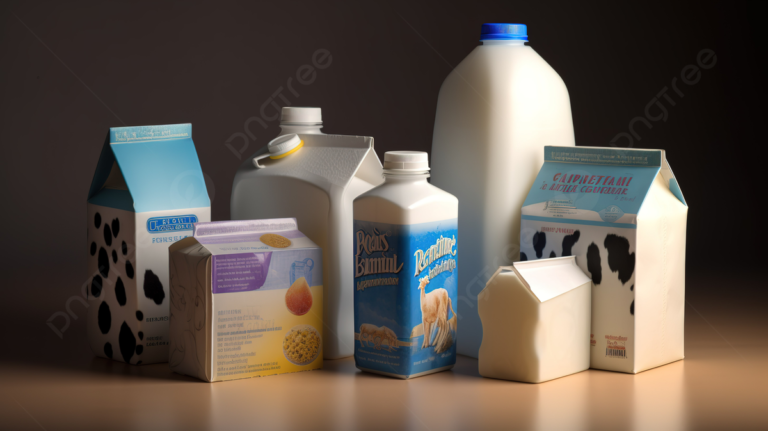
Between 2022 and 2030, the global dairy products packaging market is expected to advance at a Compound Annual Growth Rate (CAGR) of 4.5%, with projections indicating a valuation of US$ 43.6 billion by 2030. This growth trajectory highlights the sustained demand for innovative packaging solutions within the dairy industry, driven by factors such as changing consumer preferences, advancements in packaging technologies, and the emphasis on product safety and shelf-life extension. As dairy product manufacturers seek to enhance their packaging to meet evolving consumer demands and regulatory requirements, the market for dairy products packaging is poised for significant expansion in the coming years.
Global dairy industry follows seasonality and cyclicity. Dairy product packaging across the globe is majorly divided into seven types of products or packaging formats named liquid cartons, bottles & jars, pouches, cans & jerry cans, cups & tubs, folding cartons, films & wraps, and the other packaging formats.
Europe secures the second position in the global market, reflecting parallel trends in dairy product preferences. However, the Asia-Pacific region is poised for remarkable growth in the dairy products packaging market in the forthcoming years. This surge is attributed to the preferences of Generation Z, demonstrating a strong inclination toward dairy products, particularly focusing on cheese and paneer. The dynamic evolution of consumer tastes and preferences, notably in the Asia-Pacific region, is expected to be a driving force behind substantial growth in the dairy products packaging industry.
Request Sample Report: https://www.futuremarketinsights.com/reports/sample/rep-gb-638
Growth Drivers:
- Increasing Consumption of Dairy Products: The rising demand for dairy products such as milk, cheese, yogurt, and butter among consumers globally is a significant driver for the packaging market. As more dairy products are consumed, the need for efficient and sustainable packaging solutions increases.
- Growing Health Awareness: With increasing health consciousness among consumers, there’s a shift towards healthier dairy options like low-fat milk, Greek yogurt, and probiotic-rich products. Packaging that ensures freshness, hygiene, and convenient consumption aligns with these preferences.
- Innovations in Packaging Technology: Advancements in packaging technology, including materials, designs, and manufacturing processes, drive market growth. Innovations like sustainable packaging materials, active and intelligent packaging, and improved shelf-life extension techniques enhance the appeal and functionality of dairy packaging.
- Convenience and Portability: Busy lifestyles and on-the-go consumption patterns fuel the demand for convenient and portable dairy packaging solutions. Single-serve packaging formats, resealable pouches, and grab-and-go options cater to the needs of modern consumers, driving market growth.
- E-commerce and Online Retailing: The proliferation of e-commerce platforms and online grocery shopping channels has expanded the reach of dairy products to a wider consumer base. This trend necessitates robust packaging solutions that ensure product integrity during transit and delivery, stimulating market growth.
Industry Restraints:
- Environmental Concerns: The dairy products packaging industry faces increasing scrutiny over its environmental impact, particularly concerning plastic pollution and waste generation. Pressure to adopt sustainable packaging solutions and reduce reliance on single-use plastics poses challenges for market players.
- Regulatory Compliance: Stringent regulations and standards governing food packaging, safety, and labeling impose compliance burdens on industry participants. Meeting regulatory requirements while maintaining cost-effectiveness and product integrity can be challenging, particularly for smaller manufacturers.
- Cost Pressures: Fluctuations in raw material prices, especially for plastic resins, can impact packaging manufacturing costs. Market players face the challenge of balancing cost considerations with the need for quality, functionality, and sustainability in packaging solutions.
- Supply Chain Disruptions: Disruptions in the supply chain, whether due to natural disasters, geopolitical tensions, or other unforeseen events, can affect the availability of packaging materials and components. Such disruptions can lead to delays, increased costs, and logistical challenges for dairy product manufacturers.
- Changing Consumer Preferences: Evolving consumer preferences, including preferences for alternative dairy products (e.g., plant-based alternatives), organic options, and niche products, pose challenges for traditional dairy packaging manufacturers. Adapting to shifting consumer trends and preferences requires flexibility and innovation within the packaging industry.
Competitive Landscape
The leading players in dairy products packaging market are harping on innovation of products to keep the interest of consumers going.
- Stanpac Inc. has unleashed bio-based polyethylene resin coating (sourced from sugarcane) as a barrier to moisture and vapour constituting recycled fiber in huge concentration.
Key Companies Profiled :
- Mondi Group,
- WestRock Company,
- Bemis Company Inc.,
- CKS Packaging,
- Sealed Air Corporation,
- Barry-Wehmiller Companies,
- Nampak Ltd.,
- Airlite Plastics,
- ELOPAK,CLONDALKIN Group Holdings,
- Saint-Gobain S.A.,
- Saudi Basic Industries Corporation,
- Stora Enso Oyj,
- Evergreen Packaging,
- Ahlstrom,
- Rexam,
- Huhtamaki Group,
- International Paper Company,
- Consolidated Container Company LLC,
- Tetra Pak.
Buy Now/Purchase: https://www.futuremarketinsights.com/checkout/638
Key Segmentations:
By Type:
- Bags and Wraps
- Bottles
- Cans
- Cartons & Boxes
- Cups
- Films & Wraps
- Pouches
- Tubes
- Others
By Application:
- Milk
- Cheese
- Frozen Products
- Yogurt
- Cream
- Butter and Ghee
- Ice-cream
- Cultured Products
- Others
By Material:
- Glass
- Metal
- Paperboard & Paper
- Plastic
- Others
By Distribution Channel:
- E-Commerce
- Specialty Retailers
- Supermarkets & Hypermarkets
- Others
About Future Market Insights (FMI)
Future Market Insights, Inc. (ESOMAR certified, recipient of the Stevie Award, and a member of the Greater New York Chamber of Commerce) offers profound insights into the driving factors that are boosting demand in the market. FMI stands as the leading global provider of market intelligence, advisory services, consulting, and events for the Packaging, Food and Beverage, Consumer, Technology, Healthcare, Industrial, and Chemicals markets. With a vast team of ~400 analysts worldwide, FMI provides global, regional, and local expertise on diverse domains and industry trends across more than 110 countries.
Contact Us:
Future Market Insights Inc.
Christiana Corporate, 200 Continental Drive,
Suite 401, Newark, Delaware – 19713, USA
T: +1-845-579-5705
For Sales Enquiries: sales@futuremarketinsights.com
Website: https://www.futuremarketinsights.com
LinkedIn| Twitter| Blogs | YouTube




